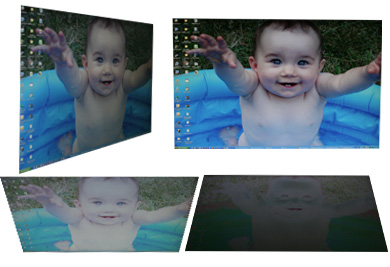How LCD makers lie to you about viewing angles

I was in a large computer store looking at computer LCD monitors and a lady was asking about which one was the better one to buy. A man (presumably her family) told her that the ones which indicated TFT (Thin Film Transistor) were the ones to buy. I then interjected that everything was TFT and it's been that way since the extinction of those ugly STN passive matrix LCDs 8 years ago they use to sell with the cheaper laptops. Of course this invariably invited more questions as to which LCD was the better buy and better quality so I spent a few minutes showing them some of the shortcomings to many of these displays.
The first thing I noted was the poor viewing angle of every LCD on the display with the exception of a single model. To see this in effect, simply lower your head a few inches in front of the monitor and you will see the brightness of the entire display dim dramatically. Looking at the display from the bottom makes the image almost darken to the point of being black with some weird hues showing. Many of these displays don't even look right when viewed at a slightly down angle since the color will change drastically. Case in point, look at the photos below of a typical LCD monitor which uses the most common TN (twisted nematic) technology.

What's extremely frustrating is that the manufacturer claims that this display has a vertical viewing angle of 160 degrees. Yet the image above came from a photograph shot at 50 degrees above and below which indicates a 100 degrees spread. If we wanted to be extremely generous, we could say that the top-down view pictured bottom left is barely acceptable (it isn't as far as I'm concerned), but the bottom-up view is flat out atrocious and there is no way in hell you can tell me that's an acceptable image at this viewing angle.
In reality, the usable viewing angle of this display vertically is about positive 35 degrees to negative 10 degrees at best and that's being generous. But looking at the vendor specifications, there is no way that you as the consumer would know this when you're making the purchase. Now I don't have a problem with the actual specs at the price they're selling it at, but I do have a big problem with the deceptive advertising.
Only one of the LCD monitors out of about 30 models being shown on the show floor was viewable from all angles and it was most likely using PVA (Patterned Vertical Alignment) technology but it was about 30% more expensive than other displays of comparable size. It looked like something like the image below which is actually quite viewable at any angle. Furthermore, these displays typically offer true 8 bit per color or even 10 bits per color whereas the TN type displays are limited to 6 bits per color.
So the old adage that you get what you pay for holds true when it comes to LCD monitors, but manufacturers need to be honest with their customers. I purposely avoided singling out any single manufacturer because they all do the same thing, but this kind of deceptive advertising needs to stop.
[poll id=39]